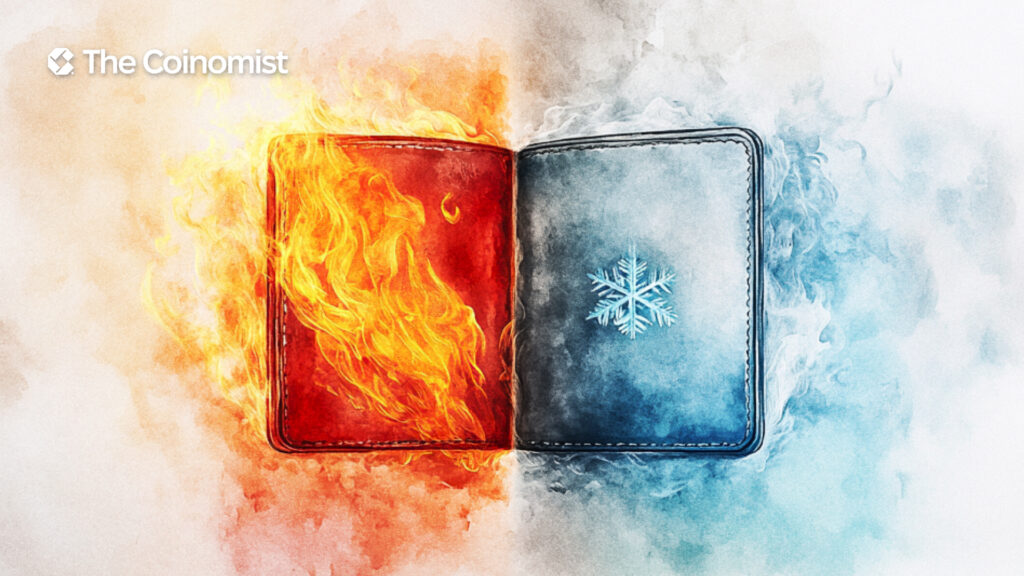How Are Cryptocurrency Hot Wallets Different from Cold Wallets?

A comprehensive guide comparing hot and cold crypto wallets. Learn their key security features, convenience, and costs to decide which storage suits your digital assets.
On this page
- What Is a Cryptocurrency Wallet?
- Types of Cryptocurrency Wallets
- What is a Hot Wallet?
- Key Features of Hot Wallets:
- What is a Cold Wallet?
- Key Features of Cold Wallets:
- Differences Between Hot Wallets and Cold Wallets
- 1. Security
- 2. Accessibility and Convenience
- 3. Use Cases
- 4. Cost
- 5. Risk of Loss
- Which Crypto Wallet Is Right for You?
- FAQs
- 1. How are cryptocurrency hot wallets different from cold wallets?
- 2. What are the disadvantages of hot wallets?
- 3. Is Coinbase a hot or cold wallet?
- 4. Which is better: hot wallet or cold wallet?
Cryptocurrency wallets are essential for anyone looking to store, manage, and secure digital assets like Bitcoin, Ethereum, and many other cryptocurrencies. These wallets come in two primary forms: hot wallets and cold wallets. Each of these wallets has its own unique set of features, advantages, and disadvantages, which serve different use cases depending on the needs of the user. In this article, we will thoroughly explore the differences between cryptocurrency hot wallets and cold wallets, providing a comprehensive understanding of their unique characteristics, security measures, and how they fit into the broader cryptocurrency ecosystem.
What Is a Cryptocurrency Wallet?
Before diving into the differences between hot and cold wallets, it’s crucial to understand what a cryptocurrency wallet is. A cryptocurrency wallet is a digital tool that allows users to store and manage their private keys, enabling them to interact with the blockchain. There are two essential components to a cryptocurrency wallet: the public key and the private key.
- Public Key: This acts like an account number or email address. It is used to receive cryptocurrencies.
- Private Key: This functions like a password. It is used to sign transactions and access the cryptocurrencies stored in the wallet. The private key should always be kept secure.
Cryptocurrency wallets allow users to send, receive, and store their digital assets. Without a wallet, it is impossible to access or manage cryptocurrency holdings.
Types of Cryptocurrency Wallets
Cryptocurrency wallets are broadly classified into two categories:
- Hot Wallets
- Cold Wallets
These two categories serve distinct purposes, and understanding their differences can help users choose the most suitable wallet based on their needs, whether for everyday transactions or long-term storage.
What is a Hot Wallet?
A hot wallet refers to a cryptocurrency wallet that is connected to the internet. Hot wallets are used for active trading or day-to-day cryptocurrency transactions. These wallets are convenient and fast, as they enable users to access their funds whenever they need them. They can come in various forms, including:
- Software wallets: These are applications or programs that users install on their computers or smartphones. They can be downloaded from official app stores or developer websites.
- Web wallets: These are browser-based wallets, meaning that they are accessed through a website.
- Mobile wallets: These are specific hot wallets for smartphones. They are available as apps that users can install from their phone’s app store.
The defining feature of a hot wallet is its constant connection to the internet, which allows users to quickly send and receive cryptocurrencies. However, this same feature also makes hot wallets more vulnerable to hacking attempts and online attacks.
Key Features of Hot Wallets:
- Internet Connectivity: Hot wallets are always connected to the internet, allowing for quick access and transaction capabilities.
- Convenience: Users can quickly access their funds and make transactions without any delays.
- Ease of Use: These wallets are generally more user-friendly, with intuitive interfaces and simple setup processes.
- Multiplatform Support: Hot wallets can be used across multiple devices such as desktops, smartphones, and tablets.
What is a Cold Wallet?
A cold wallet, on the other hand, is a cryptocurrency wallet that operates offline. These wallets are not connected to the internet, which makes them significantly more secure compared to hot wallets. Cold wallets are primarily used for long-term storage, where users are not actively trading or transferring their cryptocurrency. By keeping assets offline, cold wallets are much less vulnerable to hacking, phishing, or malware attacks.
Cold wallets come in two main forms:
- Hardware wallets: These are physical devices, often resembling USB drives, that store a user’s private keys offline. Users can connect the device to a computer or mobile device when they want to make a transaction.
- Paper wallets: A paper wallet is simply a physical printout containing a user’s private and public keys. Since it is offline, it is immune to online threats, but users must take extra care to protect the paper from physical damage or loss.
Key Features of Cold Wallets:
- Offline Storage: Cold wallets are not connected to the internet, which drastically reduces the risk of cyber-attacks.
- High Security: Cold wallets are considered the safest way to store cryptocurrency because they are impervious to hacking attempts.
- Long-Term Storage: These wallets are ideal for holding large amounts of cryptocurrency over a long period, making them perfect for long-term investors.
- Less Convenience: Since cold wallets require physical access or connection to a device for transactions, they are not as convenient for day-to-day transactions.
Differences Between Hot Wallets and Cold Wallets
Understanding the differences between hot and cold wallets is essential for selecting the appropriate wallet based on security, convenience, and usage needs. Below is a breakdown of the key differences:
1. Security
- Hot Wallets: While hot wallets offer ease of use and quick access to funds, they are more susceptible to cyber threats due to their constant connection to the internet. Hackers can exploit vulnerabilities in these wallets to steal private keys or initiate fraudulent transactions. Malware, phishing, and exchange hacks are common ways hot wallets can be compromised.
- Cold Wallets: Cold wallets are far more secure because they store private keys offline, making them nearly impossible to hack remotely. The absence of an internet connection ensures that cold wallets are immune to online hacking attempts. However, cold wallets are not impervious to physical threats such as theft, loss, or damage.
2. Accessibility and Convenience
- Hot Wallets: Hot wallets are designed for frequent use. They allow users to quickly access and manage their funds, making them ideal for active traders or those who need to access their cryptocurrency regularly. These wallets are user-friendly and accessible on various devices, including smartphones, desktops, and web browsers.
- Cold Wallets: Cold wallets, while providing enhanced security, are less convenient. To access the funds stored in a cold wallet, users must physically access the device (e.g., a hardware wallet or a printed paper wallet). This means that cold wallets are better suited for long-term storage rather than frequent transactions.
3. Use Cases
- Hot Wallets: Hot wallets are best suited for users who are actively involved in trading or making frequent cryptocurrency transactions. They are ideal for short-term holdings or assets needed for regular use. For example, traders who are constantly buying and selling cryptocurrencies would prefer hot wallets because of their speed and ease of access.
- Cold Wallets: Cold wallets are ideal for users who wish to store their cryptocurrency for an extended period without frequent access. They are recommended for long-term investors, those holding significant amounts of cryptocurrency, or anyone who prioritizes security over convenience. Investors holding assets for months or years without the need for daily access should consider cold wallets.
4. Cost
- Hot Wallets: Most hot wallets are free or come with minimal costs. Software wallets can be downloaded and used without charge, and web wallets often have no fees for basic use. Mobile wallets are also typically free, although some advanced features may incur a cost.
- Cold Wallets: Cold wallets, particularly hardware wallets, often come with a purchase cost. Hardware wallets can range from $50 to over $100, depending on the model and features. Paper wallets are free but require the user to handle and protect them carefully.
5. Risk of Loss
- Hot Wallets: If a hot wallet is hacked or if the user forgets their password or private keys, they may lose access to their cryptocurrency. However, since the wallet is connected to the internet, recovery through backup keys or seed phrases may still be possible.
- Cold Wallets: The primary risk with cold wallets is physical loss or damage. If a hardware wallet is lost or damaged, or if a paper wallet is destroyed, the user may lose access to their funds permanently unless they have a backup. It is crucial for users of cold wallets to securely store their backup keys or recovery phrases.
Which Crypto Wallet Is Right for You?
The choice between a hot wallet and a cold wallet depends largely on your specific needs and preferences:
- Hot Wallets are best suited for:
- Frequent users who need easy and fast access to their cryptocurrencies.
- Active traders who regularly buy, sell, or transfer assets.
- Individuals who prioritize convenience over maximum security.
- Cold Wallets are best suited for:
- Long-term investors looking to store large amounts of cryptocurrency securely.
- Users who do not need frequent access to their funds.
- Individuals who prioritize security and are willing to sacrifice convenience.
In conclusion, both hot and cold wallets serve distinct purposes in the world of cryptocurrency, each offering unique benefits and trade-offs. Hot wallets are perfect for users who need quick, convenient access to their funds for regular transactions or trading, but they come with an increased risk of online threats. Cold wallets, conversely, offer unmatched security by keeping private keys offline, making them ideal for long-term storage of cryptocurrency. However, they lack the convenience of hot wallets when it comes to frequent access.
Ultimately, the best wallet for you depends on your specific needs. For everyday users and active traders, a hot wallet may be the more practical choice. For those seeking to protect large amounts of cryptocurrency over the long term, a cold wallet provides the security required to safeguard assets against potential threats. Many cryptocurrency holders use a combination of both wallet types—hot wallets for daily transactions and cold wallets for securing their long-term holdings—creating a balanced approach to managing their digital assets securely.
FAQs
1. How are cryptocurrency hot wallets different from cold wallets?
Hot wallets are connected to the internet and are designed for frequent use, offering convenience but with a higher risk of hacking. Cold wallets are offline and offer superior security, making them ideal for long-term storage but less convenient for regular access.
2. What are the disadvantages of hot wallets?
The primary disadvantage of hot wallets is their vulnerability to hacking. Since they are connected to the internet, they are susceptible to online threats, malware, and phishing attacks. They are also less secure for storing large amounts of cryptocurrency.
3. Is Coinbase a hot or cold wallet?
Coinbase is considered a hot wallet because it is an online exchange platform that stores cryptocurrency funds on behalf of its users. While Coinbase implements strong security measures, it is still susceptible to the risks associated with internet-connected wallets.
4. Which is better: hot wallet or cold wallet?
There is no definitive answer to which is better, as it depends on the user's needs. A hot wallet is better for frequent users and traders who need quick access to their funds, while a cold wallet is better for those who want maximum security and are holding cryptocurrency for long-term purposes.
In conclusion, both hot and cold wallets play essential roles in the world of cryptocurrency. By understanding the key differences between these two types of wallets, users can make informed decisions about how best to store and protect their digital assets. Whether you choose a hot wallet for daily use or a cold wallet for long-term security, it is important to understand the strengths and weaknesses of each type to keep your cryptocurrency safe.
The content on The Coinomist is for informational purposes only and should not be interpreted as financial advice. While we strive to provide accurate and up-to-date information, we do not guarantee the accuracy, completeness, or reliability of any content. Neither we accept liability for any errors or omissions in the information provided or for any financial losses incurred as a result of relying on this information. Actions based on this content are at your own risk. Always do your own research and consult a professional. See our Terms, Privacy Policy, and Disclaimers for more details.























